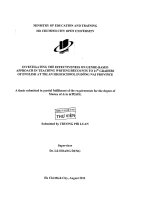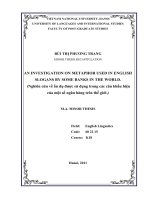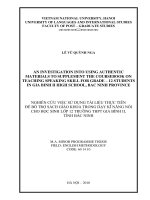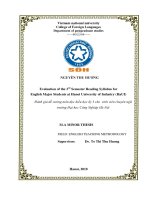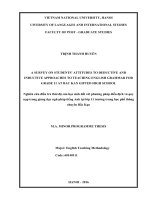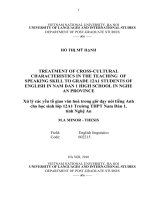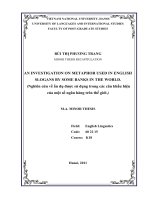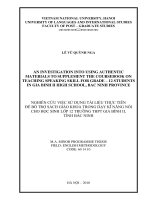AN INVESTIGATION ON VOCABULARY TEACHING IN THE ADVANCED LEVEL TEXTBOOK PROGRAM FOR ENGLISH SPECIALIZED STUDENTS GRADE 11TH IN CHU VAN AN HIGH SCHOOL
Bạn đang xem bản rút gọn của tài liệu. Xem và tải ngay bản đầy đủ của tài liệu tại đây (297.03 KB, 59 trang )
VIETNAM NATIONAL UNIVERSITY, HANOI
COLLEGE OF FOREIGN LANGUAGES
POST GRADUATE DEPARTMENT
PHƯƠNG NHÂN
AN INVESTIGATION ON VOCABULARY TEACHING IN
THE ADVANCED LEVEL TEXTBOOK PROGRAM FOR
ENGLISH SPECIALIZED STUDENTS GRADE 11TH IN CHU
VAN AN HIGH SCHOOL
NGHIÊN CỨU VỀ VIỆC GIẢNG DẠY TỪ VỰNG TRONG
CHƯƠNG TRÌNH SÁCH GIÁO KHOA NÂNG CAO DÀNH
CHO HỌC SINH LỚP 11 CHUYÊN ANH TRƯỜNG CHU
VĂN AN
M.A MINOR THESIS
FIELD
CODE
: METHODOLOGY
: 601410
HANOI, 2008
2
VIETNAM NATIONAL UNIVERSITY, HANOI
COLLEGE OF FOREIGN LANGUAGES
POST GRADUATE DEPARTMENT
PHƯƠNG NHÂN
AN INVESTIGATION ON VOCABULARY TEACHING IN
THE ADVANCED LEVEL TEXTBOOK PROGRAM FOR
ENGLISH SPECIALIZED STUDENTS GRADE 11TH IN CHU
VAN AN HIGH SCHOOL
NGHIÊN CỨU VỀ VIỆC GIẢNG DẠY TỪ VỰNG TRONG
CHƯƠNG TRÌNH SÁCH GIÁO KHOA NÂNG CAO DÀNH
CHO HỌC SINH LỚP 11 CHUYÊN ANH TRƯỜNG CHU
VĂN AN
M.A MINOR THESIS
FIELD
CODE
SUPERVISOR
: METHODOLOGY
: 601410
: ĐINH HẢI YẾN, M.Ed
HANOI, 2008
3
4
CERTIFICATE OF ORIGINALITY
I certify my authorship of the minor thesis submitted today entitled
“An investigation on vocabulary teaching in the advanced level textbook program
for English specialized students grade 11th in Chu Van An High School”
in terms of the statement of requirements for the thesis and the field study reports in
Masters’ programs is the result of my own work, except where otherwise acknowledged
and that this minor thesis or any part of the same had not been submitted for a higher
degree to any other universities or institution.
Signature
Date: December 29th, 2008
5
ACKNOWLEDGEMENTS
First of all, I wish to express my deepest gratitude to my supervisor, Ms. Dinh Hai Yen,
M.Ed, for her academic guidance and support throughout this study. Without her valuable
assistance, my thesis would not have been completed.
I would like to sincerely thank the lecturers of the Department of Post Graduate Studies,
College of Foreign Languages, Hanoi National University for their useful lessons that have
helped in the clarification of many points.
Last but not least, many special thanks are due to the teaching staff and students from
English specialized classes 11th grade in Chu Van An High School, who contributed data to
the study. Without their enthusiastic cooperation, I would not have been able to conduct
my research. I hope that the insights this paper has yielded will be of benefit for future
students in the program.
6
ABSTRACT
Vocabulary acquisition is one of the most challenging obstacles language learners
must overcome. This is especially true for students in English specialized classes where
comprehension of academic texts is required. This minor thesis investigates the vocabulary
strategy teaching component of an advanced-level course book for students in the grade
11th of Chu Van An High School. It first describes the course and the issues which
prompted the study. The present study is an effort that aims to examine the students’ usage
of vocabulary learning strategies that occurs as the course progresses and to analyse the
development of passive and active vocabularies over a three-month period. It then reviews
the literature relevant to the topic of research which serves as a theoretical for framework
for the study. The data were collected by means of questionnaires and interviews. Results
showed that students employed some certain determination, social, memory, cognitive and
metacognitive strategies during the course. However, the frequency of determination
strategies use was significantly higher than that of social and metacognive ones. The
findings emphasize the potential influence of these strategies on the learners’ vocabulary
development. Particularly, this study can claim to have achieved its goal of measuring
improvements in students’ passive vocabularies and matching them to suitable targets after
a three-month period. However, the findings from these studies have neither been
completely sufficient nor consistent, which requires further research into particular
strategies employed by learners of different proficiency levels in varied contexts. The
study has developmental implication for researchers and teachers. It provides a
categorization scheme of vocabulary learning strategies that are applicable to other studies
in this field. In addition, based on the findings, it suggests explicit instruction to improve
the efficiency of teaching vocabulary strategies.
7
TABLE OF CONTENTS
Page
Acknowledgements
Abstract
Part I: INTRODUCTION
1. Rationale
2. Scope, aims and significance of the study
2.1 Scope of the study
2.2 Aims of the study
2.3 Significance of the study
3. Methods of the study
4. Organization of the thesis
Part II: DEVELOPMENT
CHAPTER 1: LITERATURE REVIEW
1.1 Vocabulary in SLA
1.2. Linguistic Input of Word
1.2.1 Necessary information of ‘knowing’ a word
1.2.2 Receptive and Productive knowledge
1.2.3 How many words do learners need to know?
1.3 Vocabulary learning strategies
1.3.1 Determination strategies
1.3.2 Social strategies
1.3.3 Memory strategies
1.3.4 Cognitive strategies
1.3.5 Metacognitive strategies
1.4 Vocabulary teaching in language education
1.5 Summary
CHAPTER 2: METHODOLOGY
2.1 Participants and settings of the study
2.1.1 The school system
2.1.2 Vocabulary in the curriculum
2.1.3 Needs analysis
2.2 Instruments of data collection
2.2.1 Questionnaires
2.2.2 Survey
2.3 Data collection procedures
2.4 Data analysis
2.5 Summary
CHAPTER 3: RESULTS AND DISCUSSION
3.1 Results
3.1.1 Determination strategies
3.1.2 Social strategies
3.1.3 Memory strategies
3.1.4 Cognitive strategies
3.1.5 Metacognitive strategies
3.1.6 Teaching staff survey
8
i
ii
1
1
2
2
3
3
4
4
5
5
5
6
6
7
7
9
10
11
12
13
14
14
16
18
18
18
18
19
20
20
21
21
21
22
23
23
23
24
25
27
28
29
3.2 Summary of major findings
3.3 Discussion of major findings
3.4 Summary
Part III: CONCLUSION
1. Summary of previous parts
2. Conclusions
3. Implications of the study
4 Limitations and suggestions for further research
REFERENCES
APPENDIXES
Appendix 1
Appendix 2
Appendix 3
9
30
31
33
34
34
35
37
38
I
III
III
VI
VII
LIST OF ABBREVIATIONS
CFL
:
College of Foreign Language
VNU
:
Vietnam National University
CVA
:
Chu Van An High School
SSP
:
Structured Speaking Practice
SLA
:
Second Language Acquisition
10
LIST OF FIGURES
Figure 1. Vocabulary size and text coverage in the Brown corpus
(Nation and Waring, 1997, p.9)
Figure 2. Text coverage in written academic text (Nation and Newton, (1997, p.239)
Figure 3. Determination strategy survey results
Figure 4. Social strategy survey results
Figure 5. Sample of Memory strategy survey results
Figure 6. Cognitive strategy survey results
Figure 7. Metacognitive strategy survey results
11
PART I: INTRODUCTION
1. Rationale
It is common knowledge that learning a foreign language mainly involves learning
the sound system, grammar, and vocabulary of that language among which vocabulary
learning plays a very crucial role. Seal, (1990, as cited in Celce-Murcia, 1991, p.269) state
that
to the non-language specialist, the common sense how languages are learned is
that you substitute the words in your first language for the corresponding words in
the second language. Words are perceived as the building blocks upon which
knowledge of the second language can be built.
Considering the crucial role attributed to vocabulary learning in second or foreign
language learning, one can implicitly understand the importance of vocabulary teaching as
well. In the past, vocabulary teaching and learning were often given little priority in second
language programs, but recently there has been a renewed interest in the nature of
vocabulary and its role in learning and teaching (Richards & Renandya, 2002).
A number of research studies have dealt with lexical problems, that is, problems
which language learners face in vocabulary learning. The given research findings have
revealed that lexical problems frequently interfere with communication. As a matter of
fact, communication breakdown occurs when people do not use the right words (Allen,
1983).
It is also generally accepted that second or foreign language learners who possess
good word power or knowledge of vocabulary are usually more successful language
learners. To put it simply, people with large vocabularies are more proficient readers than
those with limited vocabularies. In fact, there is usually a positive correlation between
one’s knowledge of vocabulary and his/her level of language proficiency (Luppescu &
Day, 1993).
In most English classrooms in Vietnam today, a significant amount of time is spent
on lexis teaching and learning. Indeed, many EFL learners favour the type of vocabulary
book that lists words frequently appearing in entrance examinations. However, these are
unhelpful for the communicative purposes since they do not present information on usage.
Therefore, considering the treatment of lexis in current English textbooks for EFL learners
12
and what improvements that could be made has become a major concern for language
professionals nationwide. The significance then is not simply a focus on lexical elements,
but a careful consideration of the kinds of lexical features that should be presented and
applied.
Advanced ESL (English as a Second Language) learners, particularly those who
have been admitted to English specialized classes which use English as the mode of
instruction such as the case of Chu Van An high school, ostensibly have a sizeable
vocabulary. To begin with, they must pass the school entrance exams, which test the
breadth of vocabulary at the disposition of the learner. In the English specialized classes,
vocabulary learning is of great importance to the students because they need to work with a
lot of English books and materials to support their studies. In recent advanced-level
courses I taught, the learners were expected to learn the entire Academic Word List
(Coxhead, 2000) and sublist over the course of one three-month semester. Remarkably,
the students in these particular classes consistently received 80%-100% correct answers on
AWL vocabulary quizzes, representing a gain of approximately 560 new word families.
However, apart from some students who are quite good at English, most students find
vocabulary acquisition one of the biggest challenges, especially when they have to work
with a wide range of academic materials. They often complain that they have little
understanding of the texts they have read and gain little knowledge from their reading
exercises in the advanced textbooks. Having worked with the newly developed advanced
textbooks for more than two years, I am fully aware of the students’ problems and want to
help them improve their vocabulary learning efficiency. Therefore, I intend to carry out an
investigation on vocabulary teaching in the advanced level textbook program for English
specialized class students who are in the grade 11th in Chu Van An High School.
2. Scope, aims and significance of the study
2.1 Scope of the study
The study investigates the vocabulary teaching in the advanced level textbook
program for English specialized class students who are in the grade 11 th in Chu Van An
High School. Particularly, this minor thesis only refers to the learners’ lexical strategy
training. That is how to develop learners’ lexical learning strategies in the most efficient
13
way. Thus, the study of learning and teaching strategies involving other aspects would be
beyond the scope.
2.2 Aims of the study
This study evaluates the vocabulary teaching component of an advanced English
study program. The aims of the study are:
a) to examine the students’ usage of vocabulary learning strategies that occurs
as the course progresses,
b) to analyse the development of passive and active vocabularies over a threemonth period in order to assess whether students finishing the program have
acquired sufficient knowledge of lexical items to comprehend different types of
academic texts.
To realize the given aims, an attempt is made to seek answers to the following
research questions:
(1) To what extent does the vocabulary component of the advanced level textbook
program for grade 11th students support their own vocabulary development?
(2) What is the students’ evaluation of the effectiveness towards vocabulary
learning strategies that they employ after a three – month period?
(3) What are the suggested solutions to improve the efficiency of teaching
vocabulary strategies?
2.3 Significance of the study
The study is the first one to be carried out in the field of vocabulary teaching at Chu
Van An High school. It gives a detailed description of vocabulary development used by
students in English specialized classes. More importantly, it works out changes in study
behavior over a three-month period. The findings of the vocabulary teaching of the
textbooks newly developed for the advanced level can help teachers to understand more
about their students’ vocabulary acquisition and can serve as the foundation for some
further recommendations on how to improve students’ vocabulary breadth.
14
3. Methods of the study
This study is to be conducted as a descriptive study that utilizes both quantitative
and qualitative approaches. The quantitative analysis is employed through the process of
data collected from written questionnaires to reveal changes in study behavior over a threemonth period and to measure passive vocabulary growth over the same period. In addition,
the qualitative approach is used to deal with the data collected from interviews with the
teaching staff that are fully responsible for the teaching of some 11 th English specialized
classes in Chu Van An High School. The combination of these data collection methods
will help ensure both reliability and validity of the study.
4. Organization of the thesis
The study consists of three parts:
Part I is the Introduction, which states the rationale, scope, aims, significance,
method and organization of the study.
Part II consists of three chapters.
Chapter 1 reviews the literature relevant to the topic of research and summarizes some
related studies on vocabulary acquisition, which serves as a theoretical framework for the
study.
Chapter 2 presents the research methodology of the study. It provides information about
the participants, the instruments, and the data collection procedures and data analysis.
Chapter 3 is the main part of the study that reports and discusses the main findings
according to the research questions.
Part III is the Conclusion that summarizes the major findings, presents the
implications and limitations of the study and gives some suggestions for further research.
15
PART II: DEVELOPMENT
CHAPTER 1: LITERATURE REVIEW
For long, vocabulary learning has occupied an uncertain position in literature. Since
the 1970s though, there has been a growing appreciation of the importance of lexical
knowledge for learners. This, together with the gradual shift away from prescribed
methods of teaching, has led to a greater emphasis on developing the use of learning
strategies. Until recently, however, there have been few attempts to accurately describe the
strategies that learners can bring to bear on the task of acquiring vocabulary (Schmitt,
1997, p.199). Several key questions stand out regarding current thinking on vocabulary
learning, some of which attract a remarkable consistency of opinion, while others provoke
more debate.
1.1 Vocabulary in SLA
Some specialists in methodology believe that the meaning of words can not be
adequately taught, so it is better not to try to teach them. Others in methodology fear that
students would make mistakes in sentence construction if too many words are learned
before the basic grammar has been mastered. Actually, vocabulary learning is not simply a
matter of learning that a certain word in one language means the same in all contexts. It is
widely accepted that vocabulary is more important than grammar in SLA. Firstly, words
still can be used to communicate successfully without the grammatical correction. For
example, as in baby’s utterance “Mummy, water”, one can easily get his intention that he
asks his mother for water, although his utterance which lacks a subject and a predicate is
grammatically wrong. Secondly, knowledge of grammar is limited but that of words are
not. Thus, learning vocabulary should last as long as the language is being in use.
Vocabulary breadth in learning a foreign language is viewed as a primordial factor
in successful communication and, to a great extent, in high-level reading ability and
comprehension. Furthermore, reading itself is frequently singled out as the most important
vocabulary-building activity both for the first language (L1) and the second language (L2).
The impact of reading on vocabulary acquisition outweighs by far the impact of aural
language because of the relatively simple lexicon used in the spoken language (Krashen,
1989, p. 455). A large number of the studies on SLA (e.g., Horst, Cobb, & Meara, 1998;
16
Knight, 1994; Krashen, 1989; Nagy, Herman, & Anderson, 1985; Nation & Coady, 1988)
examine the role of context in vocabulary acquisition which takes place through reading or
reading-associated tasks. Context plays a significant role in this acquisition by supplying
the necessary input. In many cases, the vocabulary acquisition which occurs while we are
reading is incidental and is largely dependent on the learners' guessing (Krashen, 1989).
However, numerous articles concerned with the controversy between guessing from
context and the use of a dictionary or glosses (marginal or computerized) in L2 acquisition
provide data in favor of dictionary/ gloss use in addition to vocabulary embedded in a
natural context (Groot, 2000 ; Hulstijn, 2000 ; Lomicka, 1998; Lyman-Hager & Davis,
1996; Summers, 1988). Dictionaries are particularly helpful for rarely occurring, lowfrequency words and for cases where the subjects do not have enough background for
correct guesses. Moreover, even a correct guess does not necessarily lead to acquisition.
This conclusion can be explained by the assumption that learners who guess words
correctly do not pay sufficient attention to the link between form and meaning in the
learning stage nor think they know the words well.
1.2 Linguistic Input of Word
1.2.1 Necessary information of ‘knowing’ a word
It is important for learners to recognize that there is more to ‘knowing’ a word than
checking its definition in a dictionary. Teachers need to emphasize that vocabulary
learning is an incremental, ongoing process, and that learners will be able to improve their
understanding of words by encountering them repeatedly.
Word knowledge can be thought of as encompassing three elements: the word’s
form, meaning and use. Knowledge of form might include phonological and orthographical
form as well as any recognizable word parts. Beyond the word’s definition as given in a
dictionary, meaning also encompasses connotation and synonyms. Using the word requires
an understanding of appropriate grammatical function, common collocations, appropriacy
in different contexts and frequency of use, all of which can be acquired from incidental
exposure to language (Ellis, 1997, p.127).
In Laufer’s study (1998) of vocabulary development in Israel high school students ,
productive knowledge is further subdivided into two parts. Controlled productive
17
knowledge can be accessed when prompted by a task but free productive knowledge is
used spontaneously without prompts. This is an important point, since learners who are
being prompted to use a particular word are being provided with a context, and are
therefore not exhibiting complete control of a lexical item unaided. It is only when items
are used appropriately without any prompts that a teacher can be sure that an item has been
fully acquired.
1.2.2 Receptive and Productive knowledge
Much has been written about receptive and productive vocabulary. However, very
little work has been done to distinguish the two. More importantly, we must be careful
when using the terms 'receptive' and 'productive' and we don't necessarily know what we
are talking about when we refer to receptive or productive vocabulary nor do people agree
what they exactly are . It is not certain by any means that the two can be so neatly
separated.
Many attempts have been made to distinguish the terms 'receptive' and 'productive'
from theoretical and quantitative perspectives. These terms differ in productive use and
require more accurate mastery of connotations and denotations, register, syntactic
constraints, co-occurrence restrictions and so on. Quantitatively, Waring (1996b,
forthcoming) look at the relative vocabulary size of some Japanese learners of English and
found a difference between ‘receptive’ ‘and productive’ terms He found that if a high
frequency word was known receptively, there was good chance (64%) that it would be
known productively. However, if a low frequency word was known receptively there was
little chance (15%) it would be known productively. This means that we know far many
more words receptively than productively, but that there is no linear relationship between
the amounts known.
1.2.3 How many words do learners need to know?
Two possible answers to this question are offered. The first is that learners should
attempt, as far as is possible, to match the vocabularies of native speakers. The second
answer is to learn vocabulary in increments, based on the frequency, and therefore likely
usefulness, of each group of words.
18
When estimating the vocabulary size of native speakers, the number of word
families known appears to be a commonly accepted measure. A word family is defined as a
head word, plus its inflected and derived forms. Recent conservative estimates of the
vocabulary size of an educated native speaker have been around 20,000 word families. The
growth rate of a native speaker’s vocabulary is estimated at approximately 1,000 word
families a year during early life (Nation and Waring, 1997, p.7). This is a challenging, yet
not insurmountable goal for a learner, but obviously is a long-term goal and as such is of
little use to the lower level learner.
A more practical solution for learners would be to make use of the frequency of
information provided by corpora, and in particular to concentrate initially on the most
frequent words and then to move on to less frequent items. Figure 1 shows the percentage
of text covered by vocabularies of increasing sizes.
Vocabulary size Text coverage
1,000
72.0 %
2,000
79.7 %
3,000
84.0 %
4,000
86.8 %
5,000
88.7 %
6,000
89.9 %
15,851
97.8 %
Figure 1. Vocabulary size and text coverage in the Brown
corpus
(Nation and Waring, 1997, p.9)
As can be seen in the table, each increase in vocabulary size is accompanied by
greater text coverage, but at each level, the increase in coverage becomes smaller and
smaller. Therefore, it is likely that learners will reach a point in their studies when learning
the next 1,000 words would be inefficient; they would benefit more by focusing on
vocabulary appropriate to their own likely English needs. The question is of course, how
are we to know when that point has been reached?
19
In a 1990 study of written academic text, Nation and Newton produced the
following table of text coverage.
Level
High-frequency
words
Academic vocabulary
Technical vocabulary
Low-frequency words
Total
Number of words Text coverage
2,000
87 %
800
2,000
123,200
128,000
8%
3%
2%
100%
Figure 2. Text coverage in written academic
text
(Nation and Newton, (1997, p.239)
Using this data, Nation and Newton suggest that after the 2,000 most frequent
words that have been learned, students intending to learn English in an academic
environment would benefit from mastering the 800-word Academic Word List, rather than
the next most frequent 1,000 words in general use(1997, p.239).
1.3 Vocabulary Learning Strategies
The communicative approach to learning which became popular in the 1970s
emphasized a naturalistic, incidental approach to vocabulary learning. Krashen argued that
unconscious acquisition, through natural communication, was the only possible way to
acquire a language. Word meanings could be understood from context and repeated
encounters would help to improve the depth of understanding of each word, as well as
aiding retention. There is much to be said for naturalistic learning which provides a rich
diet of comprehensible input. Firstly, this approach closely matches our L1 learning
experience, and appeals to our sense of a ‘normal’ way of learning – there is no
memorization of word lists or other rote learning. Furthermore, the sheer number of words
to be learned, as well as those with multiple meanings, also suggests a primary role for
incidental learning (Nagy, 1997, p.71-72). The risk with explicit instruction, it is argued, is
that it is difficult to provide a sufficient number of encounters with a word for learning to
take place. Nagy also states that there is a likelihood of between one in twenty and one in
seven that a word will be learned after just one exposure.
20

